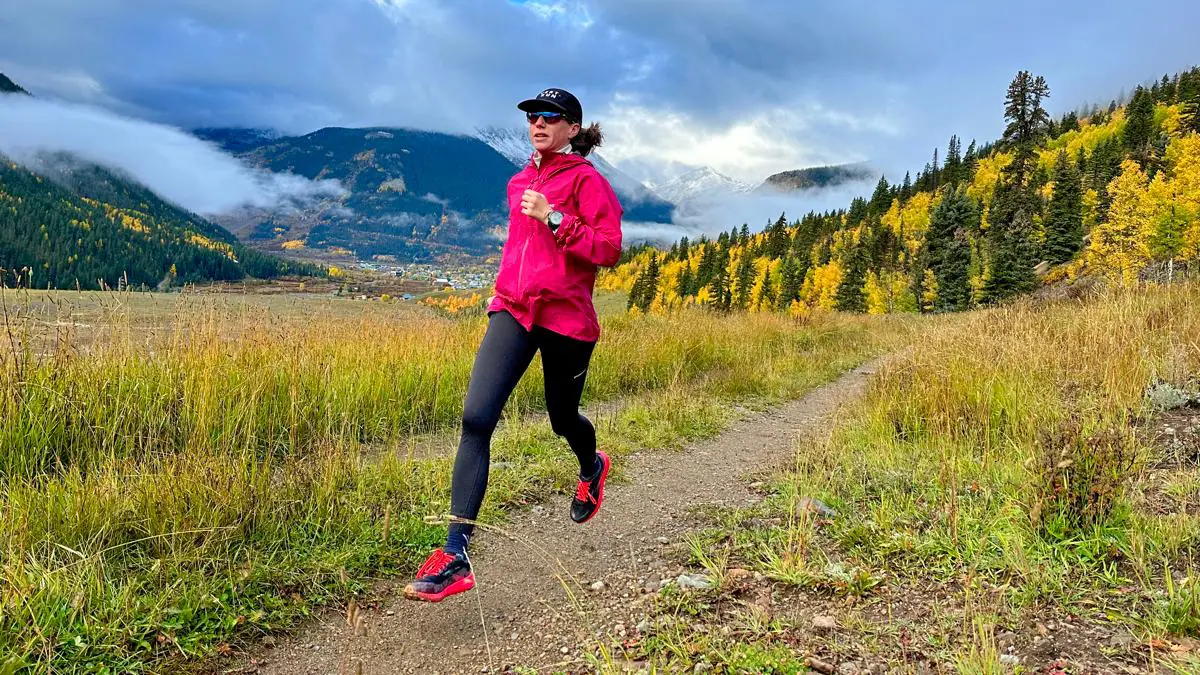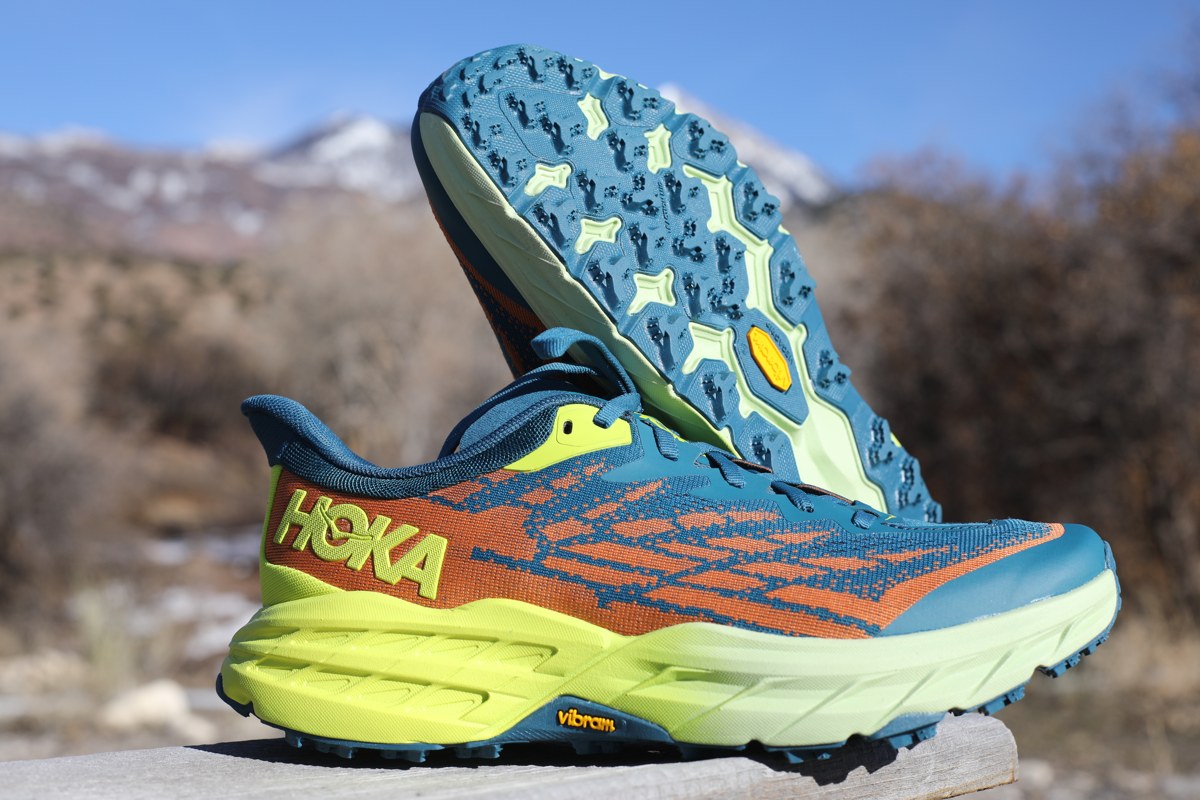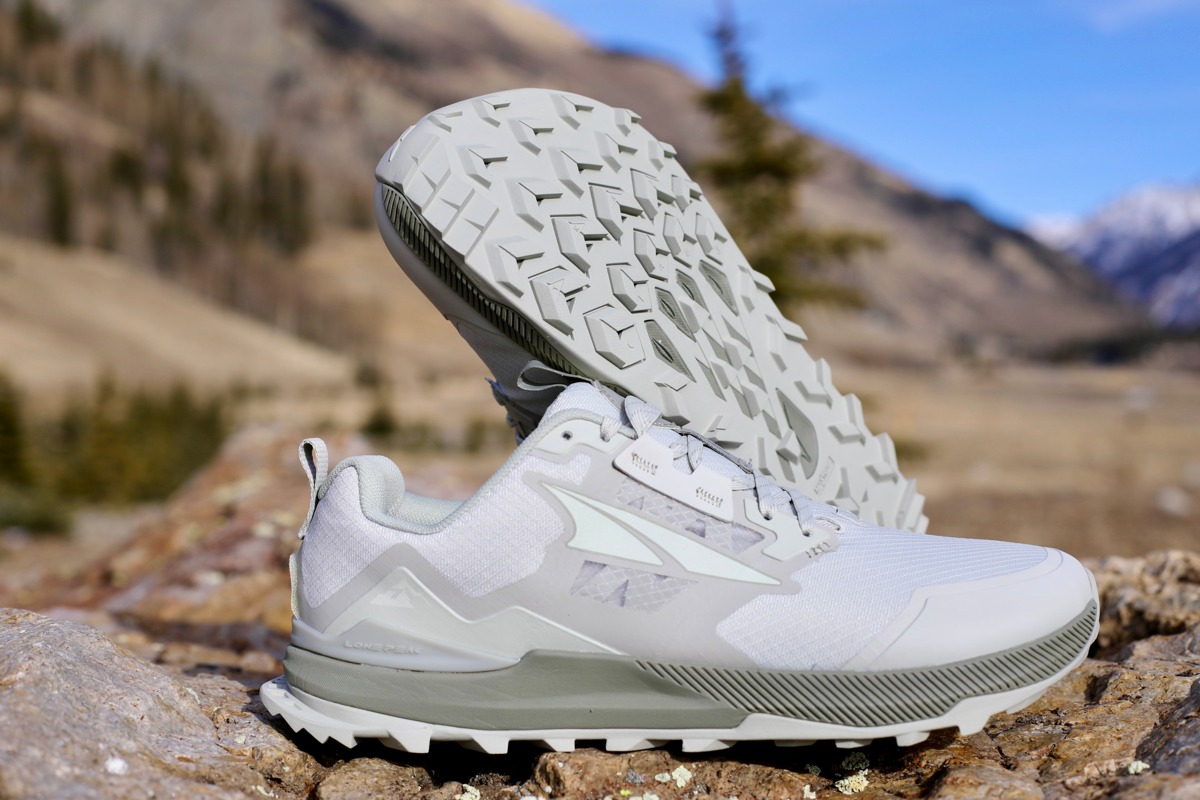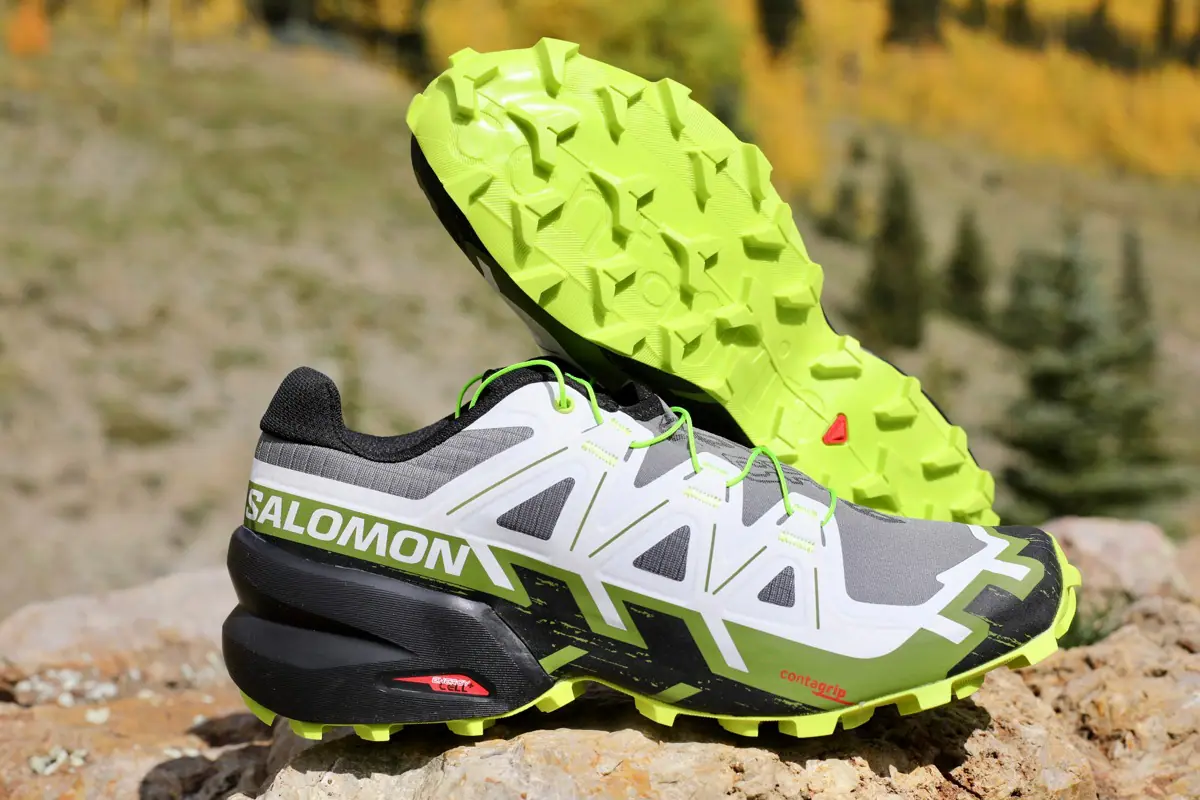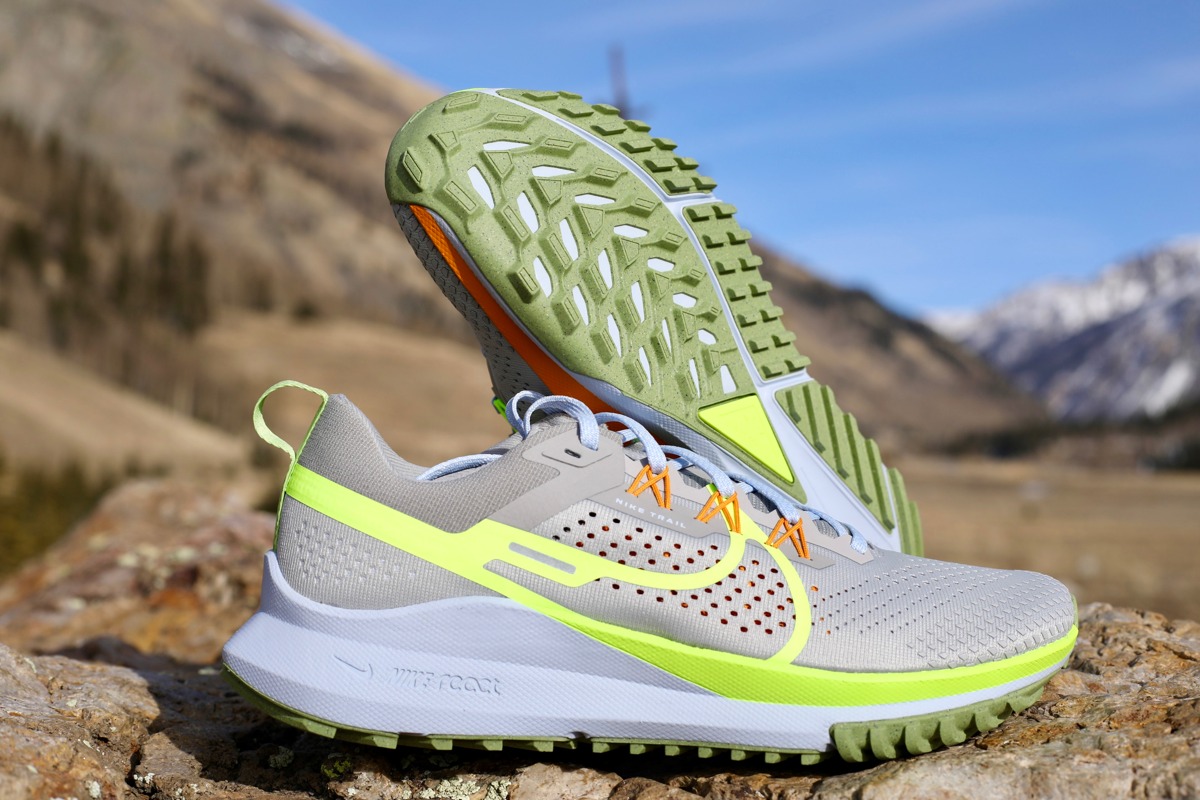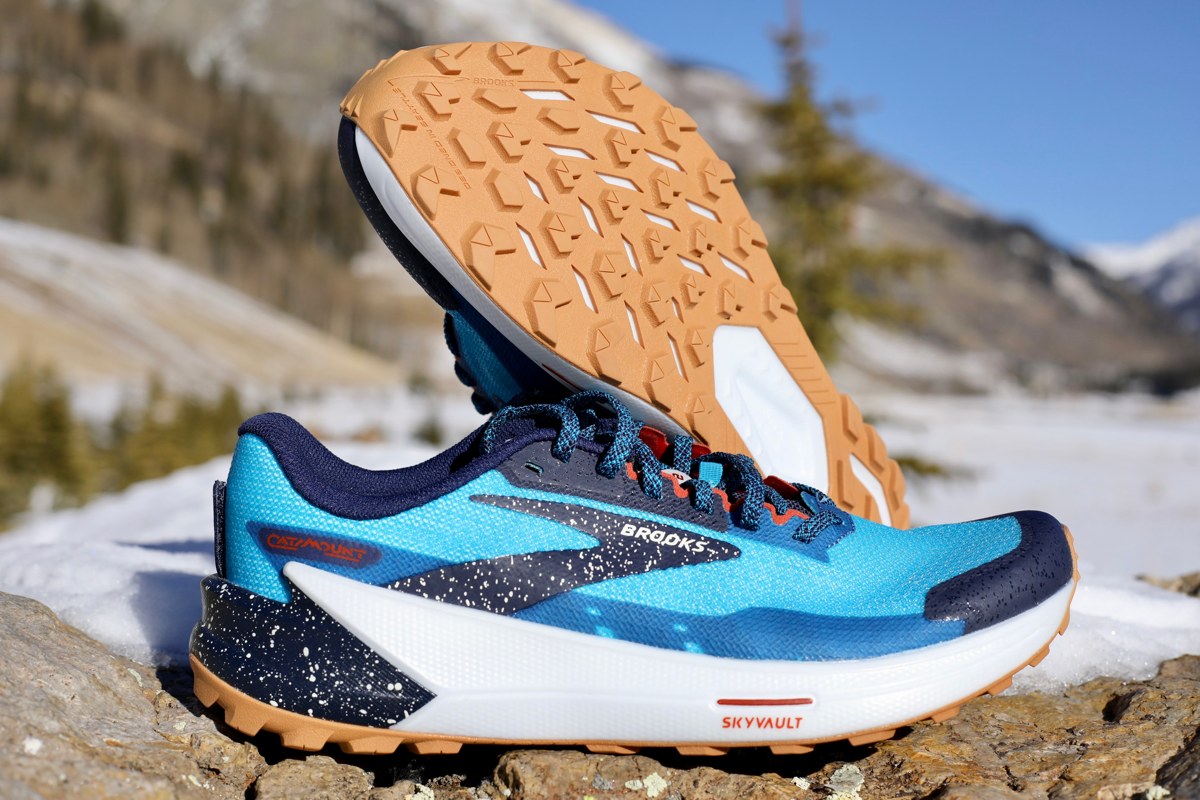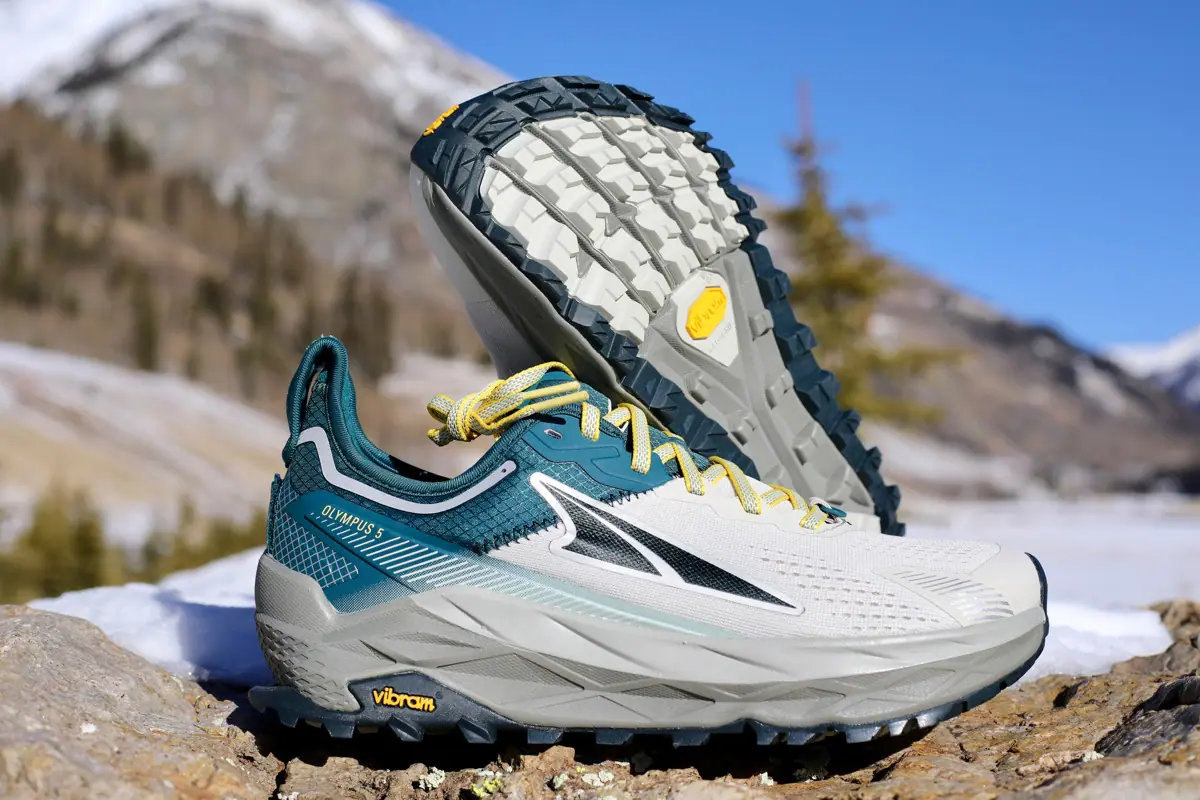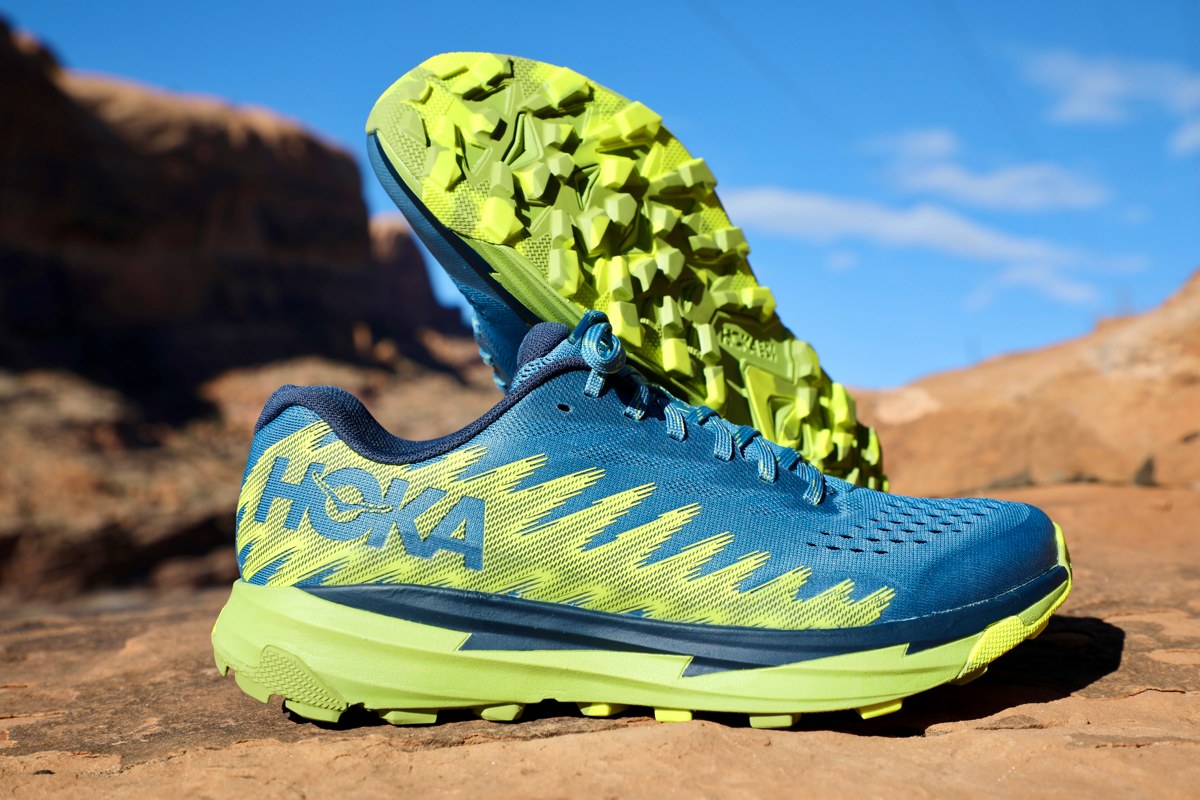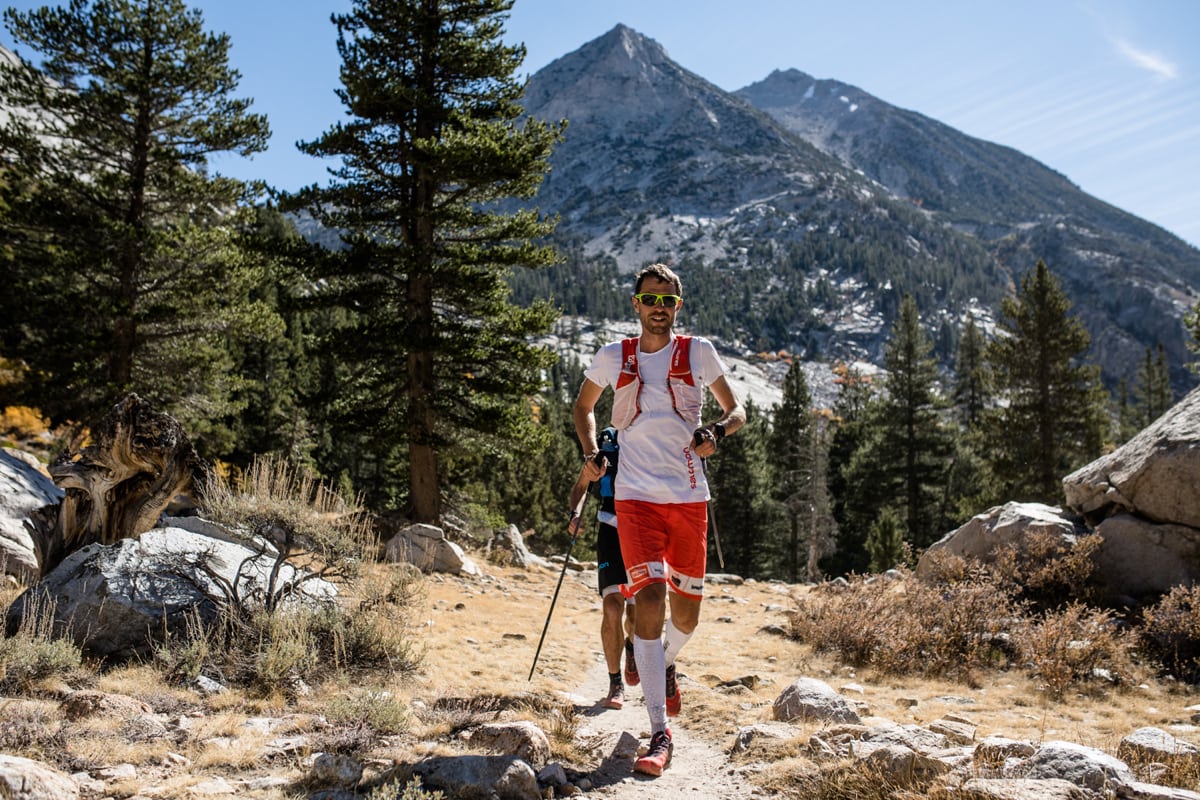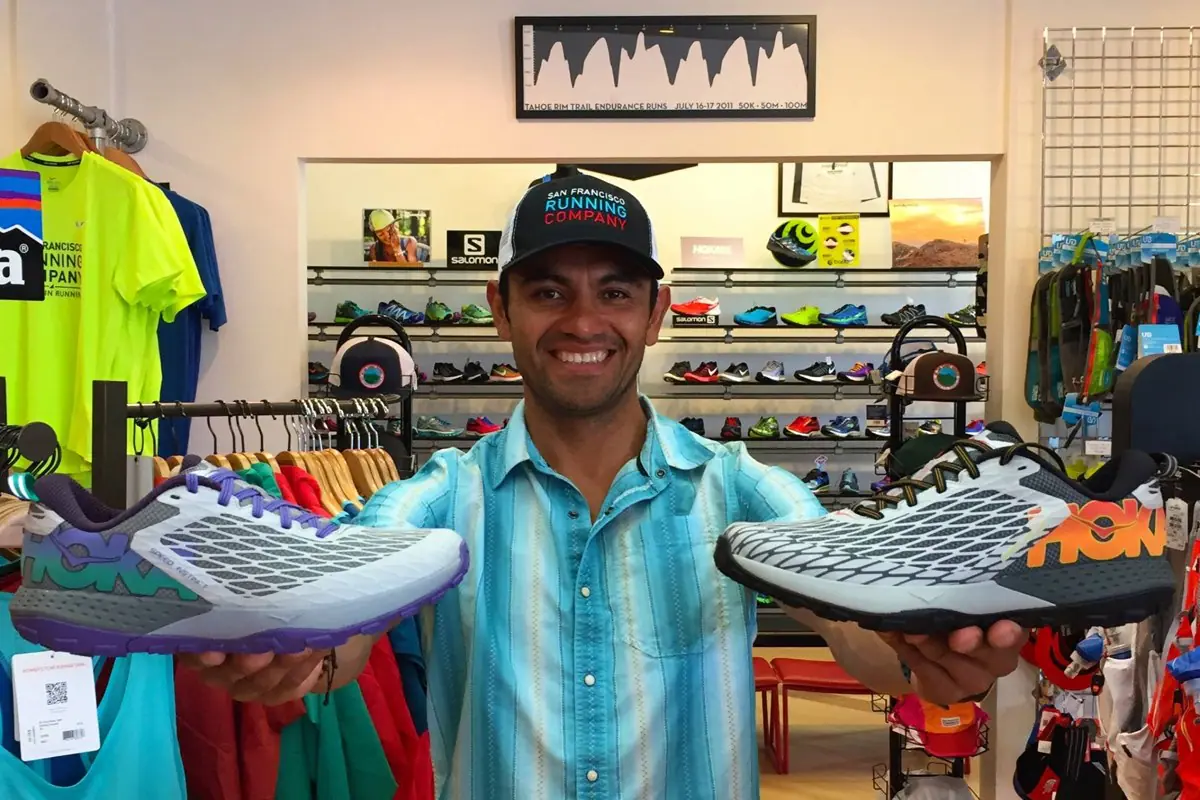It’s a glorious time to be a trail runner. Our most important piece of gear is a pair of running shoes, and there are now well over 200 trail running shoes on the market at any time. That means there are shoes for every foot, every trail, and every terrain. There are scores of capable shoes in the happy middle ground and handfuls pushing the bounds of what’s possible in various directions. The only downside to all those options is having to choose which to buy!
Below, we try to simplify things for you by picking 11 models of the best trail running shoes that should work for just about anyone in any condition! That said, we DO have more specific buyer’s guides for cushioned trail shoes, trail shoes for mud, and trail racing shoes. To learn more about selecting the right trail running shoe for you, read our recommendations for how to choose and our frequently asked questions about trail running shoes. You can also learn more about our research and testing methodology and see our glossary of trail running shoe lingo, too.
Best Trail Running Shoes – Editors’ Picks
Other Outstanding Trail Running Shoes
- Nike React Pegasus Trail 4
- Brooks Catamount 2
- Altra Olympus 5
- La Sportiva Akasha II
- Hoka Torrent 3
- Topo Ultraventure Pro
Best Trail Running Shoes – Editors’ Picks
With such extreme terrain diversity in trail running and the specific needs of our feet and bodies, there is no single best trail running shoe for everyone and every condition. In this section, we profile five incredible shoes that cover a breadth of ground as far as for whom and for what conditions they excel.
Hoka Speedgoat 5 ($155)
The Hoka Speedgoat was a hit when it launched, and it’s only gotten better through the years. With a breadth of well-cushioned trail shoes on the market these days, the Hoka Speedgoat 5 really is the standout of the group.
While it has plenty of cushioning, that cushioning isn’t so over the top as to get in the way for many trail runners. Further underfoot, there are also generous lugs made from Vibram Megagrip, which yields strong traction in most conditions. That traction has only gotten better with the addition of Vibram’s Traction Lug, which provides more outsole surface area via textured lugs.
The biggest upgrade to the Speedgoat is losing a full half-ounce per shoe. That might not sound like much, but it’ll make a difference whether you’re racing a trail 5k or are 80 miles into a 100 miler. A simplified upper should also reduce the chances of developing hotspots.
Overall, the Hoka Speedgoat 5 is a comfy shoe that can go the distance on any trail.
Full Hoka Speedgoat 5 review.
- Actual Weight (U.S. men’s 9): 10.0 ounces (284 grams)
- Drop: 4 millimeters (but less relevant with so much midsole)
- Pros: Great traction and tremendous cushion in a trail shoe that works
- Cons: Just a bit too much shoe for some runners’ liking; less foot lockdown for narrower feet than previous versions
- Other Speedgoat Versions: Wide (men’s & women’s)
Shop the Men's Hoka Speedgoat 5Shop the Women's Hoka Speedgoat 5
Saucony Peregrine 13 ($140)
Over the past decade, the Saucony Peregrine migrated from a trail racing shoe to something more in line with a classic, everyday trail shoe. However, the Saucony Peregrine 13 remains an everyday trail shoe while moving a bit back toward its racing roots by losing more than 1.5 ounces per shoe from the Peregrine 11. An outsole redesign has improved traction as well as enhanced mud-shedding capability for the sloppiest of runs.
Overall, the Peregrine 13 won’t wow you with bells and whistles, but it’s a great combination of traction, mild cushioning, sufficient underfoot protection, a breathable yet locked-down upper, and reasonably light weight. It just performs, and that’s awesome.
For those running in muddy or snowy terrain, there’s also a dedicated soft terrain model, the Peregrine 13 ST, that’s only $10 more.
Full Saucony Peregrine 13 review.
- Actual Weight (U.S. men’s 9): 9.4 ounces (265 grams)
- Drop: 4 millimeters
- Pros: Great all-around trail shoe at a reasonable price and light weight; lots of related versions in the Peregrine line
- Cons: Overlays on the upper can delaminate
- Other Peregrine Versions: Wide (men’s & women’s); Soft Terrain (men’s & women’s); Ice+ 3 winter version (men’s & women’s)
Shop the Men's Saucony Peregrine 13Shop the Women's Saucony Peregrine 13
Brooks Cascadia 17 ($140)
The Brooks Cascadia is an oldie but a goody. With a history that goes back to the early 2000s, Brooks found a winning formula in the Cascadia that it’s kept going for nearly two decades. If I had to recommend a pair of trail shoes to a new trail runner about whom I had no additional details, I’d point them toward the Brooks Cascadia 17.
Why? It’s a trail shoe that performs well on a variety of trail conditions while also still being a smooth ride on pavement as a road-to-trail shoe. In addition, the Cascadia’s 8-millimeter heel-to-toe drop should make the shoe accessible for most runners outside of low-drop enthusiasts.
With the Cascadia 17, Brooks didn’t mess too much with a good thing overall, but did improve traction with a new outsole pattern and a new outsole compound that performs better on wet surfaces. The shoes continues to provide the stable, moderately cushioned ride for which the Cascadia is known. In addition, the Ballistic Rock Shield offers plenty of protection on rocky terrain.
As it has for ages, the Cascadia 17’s upper offers simple performance along with a gusseted tongue and gaiter attachment points. Overall, our primary tester, who has a copious shoe stable, noted the Brooks Cascadia 17 is her “one pair of shoes that can run on most surfaces well. If you’re in the market for simplicity, these may be worth your while.”
Full Brooks Cascadia 17 review.
- Actual Weight (U.S. men’s 9): 11.5 ounces (325 grams)
- Drop: 8 millimeters
- Pros: An effective everyday road-to-trail shoe
- Cons: Heavier
- Other Cascadia Versions: Wide (men’s & women’s); Gore-Tex – currently the Cascadia 16 (men’s & women’s)
Shop the Men's Brooks Cascadia 17Shop the Women's Brooks Cascadia 17
Altra Lone Peak 7 ($150)
The Altra Lone Peak 7 is so many things to so many people. For many trail runners, it’s their everyday trail shoe, from a short spin on the roads to an easy run in the local park, to a 100-mile race across rugged terrain. For others, it’s a great daily wear (and occasional run) option for increasing lower leg strength and mobility outside of running.
It’s no different among hikers, who’ve flocked to the Lone Peak since its introduction. So, what’s the secret to the Lone Peak’s success? A moderate amount of cushioning atop a grippy outsole with a marvelously roomy toebox.
The Altra Lone Peak 7 perfectly continues the line’s comfortable upper, adequate cushioning, and generous toebox. The upper’s been stripped back a bit, with better breathability, but the reduced toe bumper provides noticeably less toe protection (though it’s more moderate than missing). The Lone Peak 7 is a bit heavier than its predecessor, but testers found that it “ran light.”
Underfoot, the Lone Peak is as cushioned as ever, following its switch to more resilient Altra EGO foam for the fifth generation. The shoe continues to provide solid traction for most trail conditions. Overall, the Altra Lone Peak 7 is a nimble, responsive, and yet very comfortable ride with great ground feel.
Note that for some, Altra’s zero-drop platform is a big plus, while for others, it’s a challenge. If you’re new to low- or no-drop shoes, gradually build your mileage up in Altras, letting any sore or tight calves or Achilles tendons recover between efforts.
Full Altra Lone Peak 7 review.
- Actual Weight (U.S. men’s 9): 10.2 ounces (289 grams)
- Drop: 0 millimeters
- Pros: Incredibly roomy toebox while maintaining good lockdown
- Cons: Less traction on wet rocks and logs; drifting back up in weight
- Other Lone Peak Versions: All-Weather Low 2 (men’s & women’s); LP Alpine (men’s and women’s)
Shop the Men's Altra Lone Peak 7Shop the Women's Altra Lone Peak 7
Salomon Speedcross 6 ($140)
If the Brooks Cascadia is impressive for its longevity, then the Salomon Speedcross line is equally impressive in standing the test of time. Why? Since launching in 2006, the Speedcross is only on its sixth major iteration in over 15 years! It remains a top-performing and top-selling product.
What makes the Speedcross line special is its combination of a well-lugged outsole with a bombproof upper. No matter the terrain or the conditions, you can count on the Salomon Speedcross 6 to get you where you’re going.
The already amazing combination that is the Speedcross was again improved in the Speedcross 6, this time by making the shoe more comfortable. How? Well, Salomon simplified the toebox construction and improved the midsole.
Not only does the Salomon Speedcross 6 now stand worthy for longer runs, but it’s also still an incredibly durable shoe that’ll stand up to many a mile.
Full Salomon Speedcross 6 review.
- Actual Weight (U.S. men’s 9): 10.4 ounces (295 grams)
- Drop: 10 millimeters
- Pros: An outsole and upper combo that works great in sloppy conditions; improved fit
- Cons: Can trap heat and moisture
- Other Speedcross Versions: Wide (men’s & women’s); Gore-Tex (men’s & women’s)
Shop the Men's Salomon Speedcross 6Shop the Women's Salomon Speedcross 6
Other Outstanding Trail Running Shoes
Nike React Pegasus Trail 4 ($140)
The Nike React Pegasus Trail 4 remains a great option for those running longer on the trails as well as on a mix of trails and roads. The Pegasus Trail’s strengths come from the ridiculously great React midfoam, which one tester said the previous version using the same foam “felt alive,” and the brand’s many decades of designing top-notch footwear. So, it’s no surprise the shoe is excellently constructed and plenty durable.
We previously criticized the Pegasus Trail 3 for its weight, but that’s been addressed by this update, with a U.S. men’s 9 losing 1.4 ounces (40 grams)! Part of those weight savings come from a newly designed lightweight engineered mesh that excels in hot weather.
The Pegasus Trail 4 won’t be your top choice in sloppy trails or if you’re looking for a fast and light option for shorter trail races — although it’s improved in both these areas — but it’s a great choice for just about everything else. In fact, one tester noted the earlier Pegasus Trail 3 would be “the one shoe I’d take on vacation if I don’t know the conditions I’ll be running in,” and that holds just as true with today’s React Pegasus Trail 4.
Full Nike React Pegasus Trail 4 review.
- Actual Weight (U.S. men’s 9): 9.5 ounces (270 grams)
- Drop: 9.5 millimeters for U.S. men’s 10 and 8.5 millimeters for U.S. women’s 8
- Pros: A dialed-in upper; responsive midsole foam; great insole; almost 1.5 ounces lighter than its predecessor
- Cons: None, really
- Other Pegasus Trail Models: Gore-Tex (men’s & women’s)
Shop the Men's Nike React Pegasus Trail 4Shop the Women's Nike React Pegasus Trail 4
Brooks Catamount 2 ($170)
While getting even lighter, the Brooks Catamount 2 trends back toward an everyday training shoe and ultra-distance racing shoe, whereas its predecessor was a bit more minimal. The brand added a propulsion plate to aid with uphill efficiency at the sacrifice of some ground feel. While clearly from the same DNA, the Catamount 2 is noticeably a different shoe than the original model. Still, it’s a reasonably light, highly breathable, nicely cushioned, lightly rockered shoe with impeccable construction that made the original a quick favorite at iRunFar headquarters.
The Catamount 2 could just as easily be the shoe for your first (or next) 100 miler as for your everyday run. The shoe is 100% comfortable out of the box and comfortable enough to wear on your recovery runs. In addition, a revamped outsole pattern and slightly deeper lugs make the Catamount 2 good for a wider range of trail conditions.
Full Brooks Catamount 2 review.
- Actual Weight (U.S. men’s 9): 9.6 ounces (271 grams)
- Drop: 6 millimeters
- Pros: A great balance of light weight and comfort that’s worthy of runs of any distance (even more true with the Catamount 2!)
- Cons: Extra cushioning takes away from ground feel
Shop the Men's Brooks Catamount 2Shop the Women's Brooks Catamount 2
Altra Olympus 5 ($180)
The Altra Olympus 5 is the most shoe of any offering on this list. In some ways, it’s seemingly an odd combination: Altra’s zero-drop and wide toebox that aim toward natural movement combined with a staggering amount of midsole and a structured upper that restrict natural movement. Still, it’s a combination that a segment of trail runners absolutely adores.
There’s nothing in the shoe that takes away from that roomy toebox, while the cushioning and structure make the Olympus 5 a set-it-and-forget-it trail shoe free of any worries. The Olympus 5 cuts more than half an ounce per shoe from the previous version and provides a less constrictive fit while being no less responsive or secure.
Although the story of the Olympus is its maximal cushioning, the shoe’s got traction with a moderately lugged Vibram Megagrip outsole. While the Olympus 5 will give you an amazingly comfortable ride, one big downside is a cost that sits at $180, the most expensive shoe on our list.
Full Altra Olympus 5 review.
- Actual Weight (U.S. men’s 9): 11.0 ounces (313 grams)
- Drop: 0 millimeters
- Pros: Plush comfort in a trail-worthy package
- Cons: As a maximal shoe, it can be a bit clunky; the most expensive shoe on our list
Shop the Men's Altra Olympus 5Shop the Women's Altra Olympus 5
La Sportiva Akasha II ($175)
If you want a set-it-and-forget-it shoe, consider the La Sportiva Akasha II. It’s an all-day, all-mountain, all-the-miles shoe. Underfoot, the Akasha II uses the same midsole and outsole that provided plenty of traction and comfort in its predecessor and also offers a ton of durability. While it’s the heaviest shoe on this list, it feels lighter on the foot than its weight would suggest.
On top of that platform sits a moderate-fit upper that successfully blends the mid-foot lockdown that’s essential for navigating mountainous terrain with enough give and forgiveness to stay comfortable as long as you want to run. This second version of the Akasha includes small tweaks to the upper to simultaneously improve its breathability, durability, and protection. So, if you loved the original Akasha, be sure to give the Akasha II a try if you’re looking for a trail shoe you never have to think about!
Full La Sportiva Akasha II review.
- Actual Weight (U.S. men’s 9): 11.5 ounces (325 grams)
- Drop: 6 millimeters
- Pros: All-day comfort with plenty of protection
- Cons: The heaviest shoe on this list; pricy
Shop the Men's La Sportiva Akasha IIShop the Women's La Sportiva Akasha II
Hoka Torrent 3 ($130)
Although not necessarily billed as such, the Hoka Torrent 3 is a worthy racing shoe for nearly any race distance. In contrast to the cushion-first appeal of most Hoka trail shoes, the Torrent 3 combines a very grippy outsole and a responsive yet moderately cushioned midsole in a nimble package. Looking back at the Torrent 2, Hoka described it as “a seemingly contradictory combination of cushioning and agility,” and that description still works.
For the Torrent 3, Hoka made the upper even more generous than some other Hoka models, including its predecessor, the Torrent 2. This allows for a runner’s toes to spread out some without feeling imprecise, although there’s a bit less mid-foot lockdown than the previous iteration. All in all, the Hoka Torrent 3 is a well-rounded trail shoe with plenty of traction and cushioning for most runners while being a good value at $130.
Full Hoka Torrent 3 review.
- Actual Weight (U.S. men’s 9): 9.1 ounces (257 grams)
- Drop: 5 millimeters
- Pros: A surprisingly comfortable “fast” shoe; lower profile for a Hoka, for those looking to give Hoka’s a shot
- Cons: Can lack sufficient protection on the rockiest terrain; lugs can shear off on the same terrain; the TPU overlays tend to delaminate
Shop the Men's Hoka Torrent 3Shop the Women's Hoka Torrent 3
Topo Ultraventure Pro ($150)
The Topo Ultraventure Pro is a great option for someone looking for plenty of shoe without wanting to go to fully maximal cushioning like the Hoka Speedgoat 5 or Hoka Olympus 4 reviewed above. Still, this shoe has plenty of structure and protection with a generous midsole, a rock plate, and a protective upper. The Ultraventure Pro also offers plenty of traction, even in wet or rocky situations, with a well-lugged Vibram Megagrip outsole.
The Topo Ultraventure Pro. This is a great all-day shoe without being overbuilt. Our primary tester notes, “with Topo’s generous toebox and dialed-in fit, this is a shoe that I would recommend to just about anyone.” For wearers of previous Topo shoes, the Ultraventure Pro’s ZipFoam makes for a softer and more resilient ride that would last for an entire 100-mile run.
Full Topo Ultraventure Pro review.
- Actual Weight (U.S. men’s 9): 10.4 ounces (283 grams)
- Drop: 5 millimeters
- Pros: An all-day fit and ride for any ultra distance; a no-bullshit shoe
- Cons: Lack of availability at your local running store
Shop the Men's Topo Ultraventure ProShop the Women's Topo Ultraventure Pro
Best Cushioned Trail Running Shoes
While we included some cushioned trail shoes in this guide, we took a deeper dive with a dedicated best cushioned trail running shoes guide with a larger set of both highly cushioned and moderately cushioned trail running shoes.
Best Trail Running Shoes for Mud
Most trail shoes should handle a moderate amount of mud, but for the muddiest of runs, you may want to consider dedicated shoes with enhanced traction. To find some great options, look no further than our best trail running shoes for mud guide.
Best Lightweight Trail Racing Shoes
We’ve intentionally focused our picks above on a wide variety of generalist, everyday trail running shoes. But what if you’re looking for something a bit speedier for a workout, a race, or just plain fun? Well, check out our dedicated best lightweight trail racing shoes guide to see some fast and furious trail racing models.
Other Takes on Top Trail Running Shoes
For additional expert opinions on the best trail running shoes, check out the advice found in Switchback Travel’s Best Trail Running Shoes of 2023 and GearJunkie’s The Best Trail Running Shoes of 2023.
Anatomy of a Trail Running Shoe
While we tried to be non-technical and avoid jargon in describing the shoes in this guide, there are some terms common to the trail running world that those new to it might not know.
- Heel-to-Toe Drop (or just Drop) — Heel-to-toe drop refers to the difference in height from the heel to the toe of a shoe. Currently, heel-to-toe drop in trail shoes varies from none to 12 millimeters. Some runners prefer the natural movement of no drop (see Altra Lone Peak 7), while the same can irritate the lower legs of long-time runners used to traditional running shoes with drops of 8 to 12 millimeters (see Brooks Cascadia 16). Plenty of trail shoe models offer moderate drops of 4 to 8 millimeters (see Hoka Speedgoat 5).
- Lugs — Lugs refer to the protrusions of material on the bottom of an outsole. While road running shoes often have minimal lugs, trail shoes generally have lugs that are 3- to 6-millimeters deep (see Saucony Peregrine 13). Some trail shoes designed specifically for muddy conditions can have lugs as deep as 8 to 12 millimeters! Take a look at the inov-8 X-Talon Ultra 260 V2 as well as our full best trail running shoes for mud guide for the luggiest of trail shoes.
- Midsole — This is the spongy component between an outsole and your foot. These days, midsoles are made from a wide variety of “foams” and range from minimal thickness to nearly 3 centimeters of material. For more midsole and, therefore, more cushion, consider the Hoka Speedgoat 5 or Altra Olympus 5.
- Outsole — This is the bottom-most layer of a shoe that contacts the ground. It’s generally a rubber or rubber-like compound.
- Rock Plate — The rock plate is a layer of deformation-resistant material, whether a plastic sheet, carbon plate, or other, that sits somewhere between the outsole and the sock liner. The rock plate’s purpose is to prevent injury to the bottom of the foot as rocks or roots push through the shoe from below. Rock plates vary in length from the full length of a shoe to the forefoot only.
- Toebox — The toebox is the forward cavity of a shoe where your toes go. Toeboxes tend to be narrower in trail shoes aimed at faster or more technical running, while many runners prefer roomier toeboxes as the length of their runs increases to multiple hours. For wider-than-usual toeboxes, check out the Altra Lone Peak 7, Altra Olympus 5, or Topo Ultraventure Pro.
Buyer’s Guide: How to Choose Trail Running Shoes
How should I choose a size of trail running shoes?
If you already own a pair of running shoes or other athletic shoes, then you can start by trying the same size that works for you there, particularly if you’re staying with the same brand. Historically, I would have counseled to go a half size up with some of the prominent European brands like Salomon, La Sportiva, and inov-8, but that’s becoming less of an issue these days, especially with brands giving excellent guidance as to the relative fits of particular models.
In general, once you try on a pair of trail shoes, you’ll want roughly a thumb’s width between the end of your longest toe and the end of your shoe. Much less, and you could end up with blisters under your toenails as well as more chance of injuring a toe when you kick an obstacle.
If you have too much extra room, you’ll be more prone to slide around in your shoe, which is unpleasant on uneven terrain, and you’ll be more likely to catch your toe on an obstacle.
Should I size up in trail running shoes?
In most cases, you should not size up — at least in comparison to other athletic shoes — for trail running shoes. You want a trail shoe that both locks your foot in place with a proper fit, and that’s not too long such that you could more easily catch a toe on obstacles.
Perhaps back in the day, a person might go a half size up in trail running shoes, as some brands had only “precise” fits that were great when running fast on trails or navigating technical trails but less forgiving in more relaxed trail running situations. Now, almost every brand offers trail shoes in a variety of fits, so you can choose more accommodating models rather than moving up half a size.
Although it’s become increasingly rare with the proliferation of trail shoes with more accommodating fits, occasionally, an ultrarunner may pack a pair of trail shoes that’s a half size up for events of half a day or longer, although such shoes are rarely used.
How should trail running shoes fit?
Aside from choosing the correct length as described above, you’ll want to make sure you can get a snug fit across the midfoot, from the front of the ankle to just behind your toes. This midfoot lockdown, or metatarsal lockdown, is important for keeping your foot firmly atop the outsole while making any lateral motions navigating the trail as well as when climbing and descending steep sections of trail.
Folks also have heels with varying volumes, so once you have your midfoot locked down, you’ll want to see that your heel doesn’t move too much side to side or up and down relative to the shoe. Finally, there’s the toebox. Some people always prefer generous toeboxes like those found in Altra and Topo models, like the Altra Lone Peak 7, Altra Olympus 5, or Topo Ultraventure Pro, while others prefer a more moderate toebox.
This is a matter of personal feel and preference. Some shoes, particularly specialist shoes meant for shorter distance racing, very technical terrain, or very steep conditions, may have a more “precise” fit in the toebox, but you still don’t want your toes smashed together.
If you’re aiming for ultra-distance efforts, you might choose a shoe that has at least moderate room for your toes to wiggle in the toebox, as well as a midfoot lockdown that’s less aggressive and more forgiving as your feet start to swell after hours on the trail.
What heel-to-toe drop should I choose for running shoes?
Wow! Among runners, you might as well ask about religion, sex, or politics before asking for opinions on heel-to-toe drop. We’re firmly in the camp of the right answer is what works for you.
There’s an appealing argument that humans’ natural biomechanics are based on no heel-to-toe drop, such as is found in the Altra Lone Peak 7 and Altra Olympus 5. This is an easier proposition for younger runners, those gradually easing into running, or those otherwise accustomed to low- or no-drop shoes.
Folks with a longer history of running in traditional running shoes might want to stick to trail shoes with higher 8- to 12-millimeter drop like found in the Salomon Speedcross 6 or Brooks Cascadia 16, or, at most, very gradually transition down to lower-drop shoes if desired. These days, the majority of trail shoes come with moderate drops of 4 to 8 millimeters, like the Saucony Peregrine 13, Nike Pegasus Trail 4, and Brooks Catamount 2, which seem to work for a wide range of runners.
It’s worth noting the small but growing number of trail shoes’ thick, highly rockered midsoles can negate much of the meaning and utility of heel-to-toe drop numbers.
How deep should a trail running shoe’s lugs be?
This is a classic “it depends” question. In theory, good technique should provide plenty of traction in just about any shoe in most conditions. Really. That said, shoes with 5- to 6-millimeters tall, more widely spaced lugs can be great for wet, muddy, or otherwise sloppy conditions.
Most other trail shoes will have 3- to 5-millimeter lugs that are a bit more closely spaced and work in a great variety of conditions, such that unless you live in a notoriously wet environment, shoes with lugs in this range are likely to work as your everyday trail shoe.
On the other end, there are a few trail shoes out there with widely spaced 7- to 8-millimeter lugs that are really only applicable for steep climbing and descending in very wet and muddy conditions and are most likely a later specialist addition to one’s quiver of trail shoes. There are even shoes for fell running in the U.K. with 12-millimeter lugs!
Should I buy waterproof trail running shoes?
In the vast majority of cases, no, you shouldn’t buy waterproof trail running shoes for your trail runs. If it’s snowy or rainy out, I’ll often throw on waterproof shoes to walk down the street, shovel the sidewalk, or do something in the yard. On the other hand, it’s very rare I wear them running.
It’s possible that waterproof shoes will keep your feet dry if it’s not raining, but there’s some moisture on the ground, such as dew or shallow puddles. Likewise, a waterproof shoe can keep your feet dry if there’s an inch or two of snow on the ground. If it’s actually raining, water will run down your leg, into the shoe through the ankle collar, and stay in your shoe with nowhere to drain. However, if you feel the need for waterproof trail shoes, many of the most popular trail shoe models come in a waterproof version, including the Brooks Cascadia 16 GTX, Salomon Speedcross 6 Gore-Tex, and Nike Pegasus Trail 4 Gore-Tex.
This same scenario would happen with anything more than a few inches of snow unless you’re wearing running gaiters. Waterproof shoes are similarly futile if it’s much more than 50 degrees Fahrenheit out, as foot sweat will collect in your shoes and lead to wet feet.
One side benefit of waterproof shoes is they can add a bit of warmth if it’s cold or windy. However, after a couple of hours of running in cold and dry conditions, you still may end up with damp running socks from foot sweat. Still, whether your feet are wet or dry, waterproof shoes can keep your feet a bit warmer.
Why You Should Trust Us
This best trail running shoe guide has been compiled with the expertise of more than half a century of combined trail running shoe testing experience from the iRunFar team, supplemented by extensive research and the input of hundreds of iRunFar readers.
We began by compiling and considering a list of more than 200 dedicated trail running shoes currently on the market. We whittled down this list with the broad experience of iRunFar’s readers and the expert opinions of the iRunFar team’s members, who extensively test many dozens of trail shoes each year, including each and every shoe mentioned above. Then, Bryon Powell, who’s closely followed trail running shoes for iRunFar since 2008, created this guide.
With the frequent addition of new trail running shoes and just as frequent revision of existing models, this will always be a living document. We’ll evolve it as shoes come and go from our team’s list of the best trail shoes available. Onward and upward!
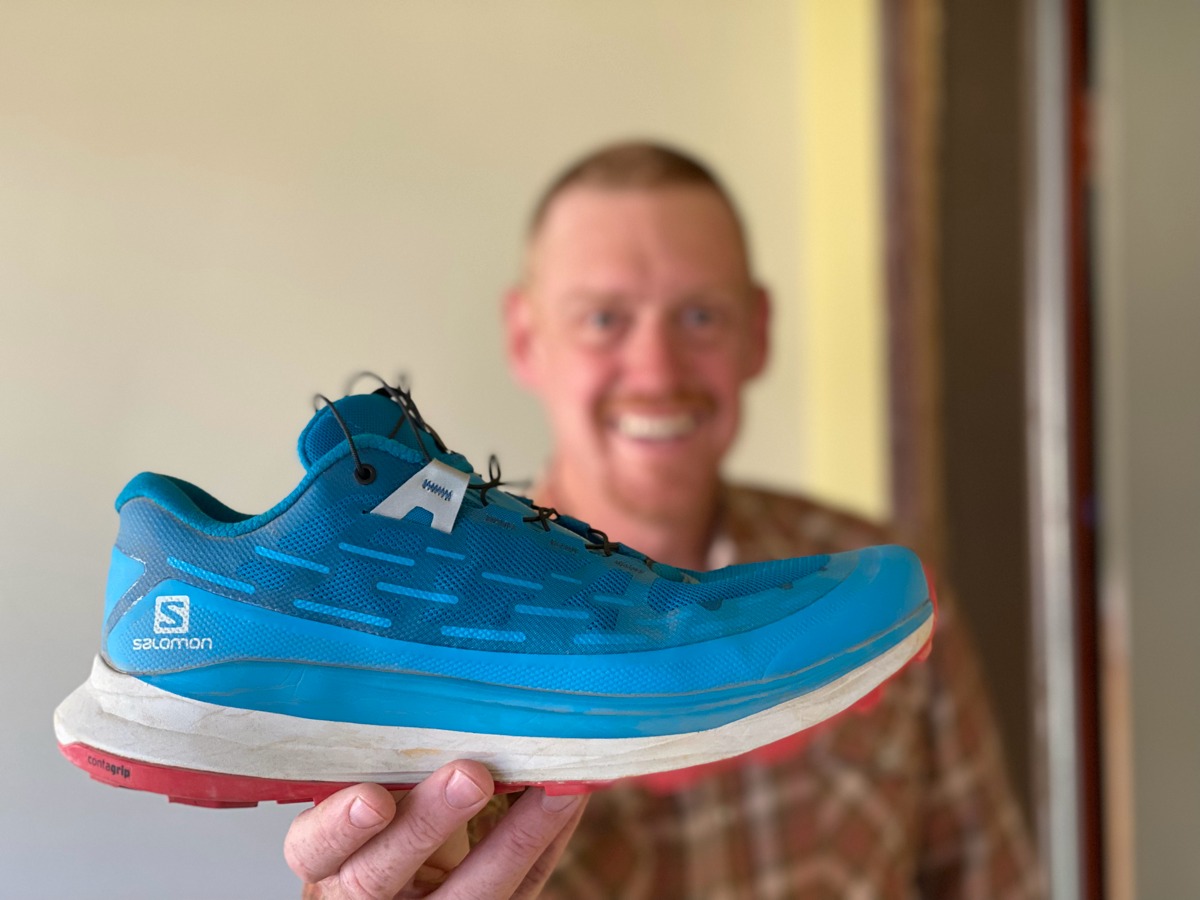
Bryon Powell’s been geeking out on trail shoes … for a couple of decades. Photo: iRunFar/Meghan Hicks
Frequently Asked Questions About Trail Running Shoes
Do you need different shoes for trail running?
Quite frankly, in all but the most extreme situations, any pair of running shoes will work on the trails. That said, read the next point as to why you might want to pick up a pair of trail shoes after all!
What makes trail running shoes different from other running shoes? What are the benefits of trail running shoes?
Trail running shoes provide a number of benefits — primarily traction, protection, and durability.
Trail shoes often offer more traction than road running shoes by having deeper, more widely spaced outsole lugs that penetrate in mud, snow, dust, and gravel to grip the ground. In addition, a trail shoe’s lugs are often made of a slightly softer and “stickier” rubber that would be a bit less durable on pavement but grippier on rocks.
The extra protection of trail shoes applies to both the top and bottom of the foot. Often a trail shoe’s upper will have a thicker cap around the toes to offer some protection when you inevitably kick a rock or root. Burlier trail shoes can have more extensive reinforcements and overlays for additional protection of the top of your foot.
Unlike even road surfaces, the uneven surface of trails can lead to rocks or roots poking through and irritating (or injuring) the bottom of your feet. The most common solution here is one of many forms of a rock plate underfoot that provides push-through protection for your feet. Trail shoes with thick midsoles and/or very deep lugs might skip a rock plate altogether if those components provide adequate separation between the trail and the sole of the foot.
When used for their intended purpose of running on trails, trail running shoes can be more durable than their road running cousins. This increased durability is primarily through material choice and construction patterns in the upper.
First, the choice of the primary material, be it mesh, a knit material, or something else, is often chosen for its ability to hold up better to the conditions trails throw at them.
Second, fabric or thin-film overlays are put overtop areas of the shoe’s upper that are more susceptible to wear, whether it’s a flex point in front of the shoe or any area more likely to collect and self-abrade with dirt.
Separately, most trail shoe outsoles are constructed in a way that it’s less likely to start detaching from the midsole, which is less of a consideration for road shoes.
What’s the difference between trail running shoes and road running shoes?
The paragraphs above highlight some of the aspects of trail running shoes that make them different than road running shoes. Road running shoes can reduce weight by minimizing outsole lug height, eliminating any rock plates for underfoot protection, and having more minimal uppers that are lighter and possibly more breathable.
What are the best trail running shoes?
These days, anyone telling you there’s a single best trail running shoe is either delusional or trying to sell you something. That said, in this guide, we’ve taken a shot at pointing out some great trail running shoes. We can fully endorse each of the shoes mentioned above.
Of our top five editors’ picks, the Hoka Speedgoat 5 is great for someone looking for more cushioning, the Altra Lone Peak 7 is perfect if you’re looking for zero drop and a roomy toebox, and the Salomon Speedcross 6 is perfect for muddy or messy conditions, while the Brooks Cascadia 16 and Saucony Peregrine 13 offer two different flavors of great everyday trail shoes.
Who makes the best trail running shoes?
There are more brands producing great trail running shoes now than ever before. That number includes many generalist brands as well as allowing some brands to find success in specific niches that work really well for some trail runners, while the same brand’s shoe might not work for others … but that’s just personal preference! For more on which brands make the best trail running shoes, check out our best trail running shoe brands article.
What are the best road-to-trail running shoes?
There’s no single best option for the road-to-trail shoe. However, coming from the trail shoe side of things, the Brooks Cascadia 16, Altra Lone Peak 7, Nike Pegasus Trail 4, and Brooks Catamount 2, each of which is described above, all make great road-to-trail shoes.
Is it ok to use trail running shoes on the road?
Yes, it’s completely fine to run with trail shoes on roads and sidewalks. Some models referred to as “hybrid” a decade ago and now more commonly referred to as road-to-trail models are specifically designed to run well on both road and trail, as many, if not most, trail runners run routes with a mix of those surfaces.
On the other hand, trail shoes designed for softer terrain often have taller, more pronounced lugs as well as less midsole, as such shoes factor in the ground providing some cushioning. This combination can lead to discomfort during prolonged stretches on pavement.
One word of caution is the outsoles of trail shoes are often made of a softer rubber than that of road shoes and can wear down more quickly on unforgiving pavement — especially if you have a stride that’s uneven or drags on the ground.
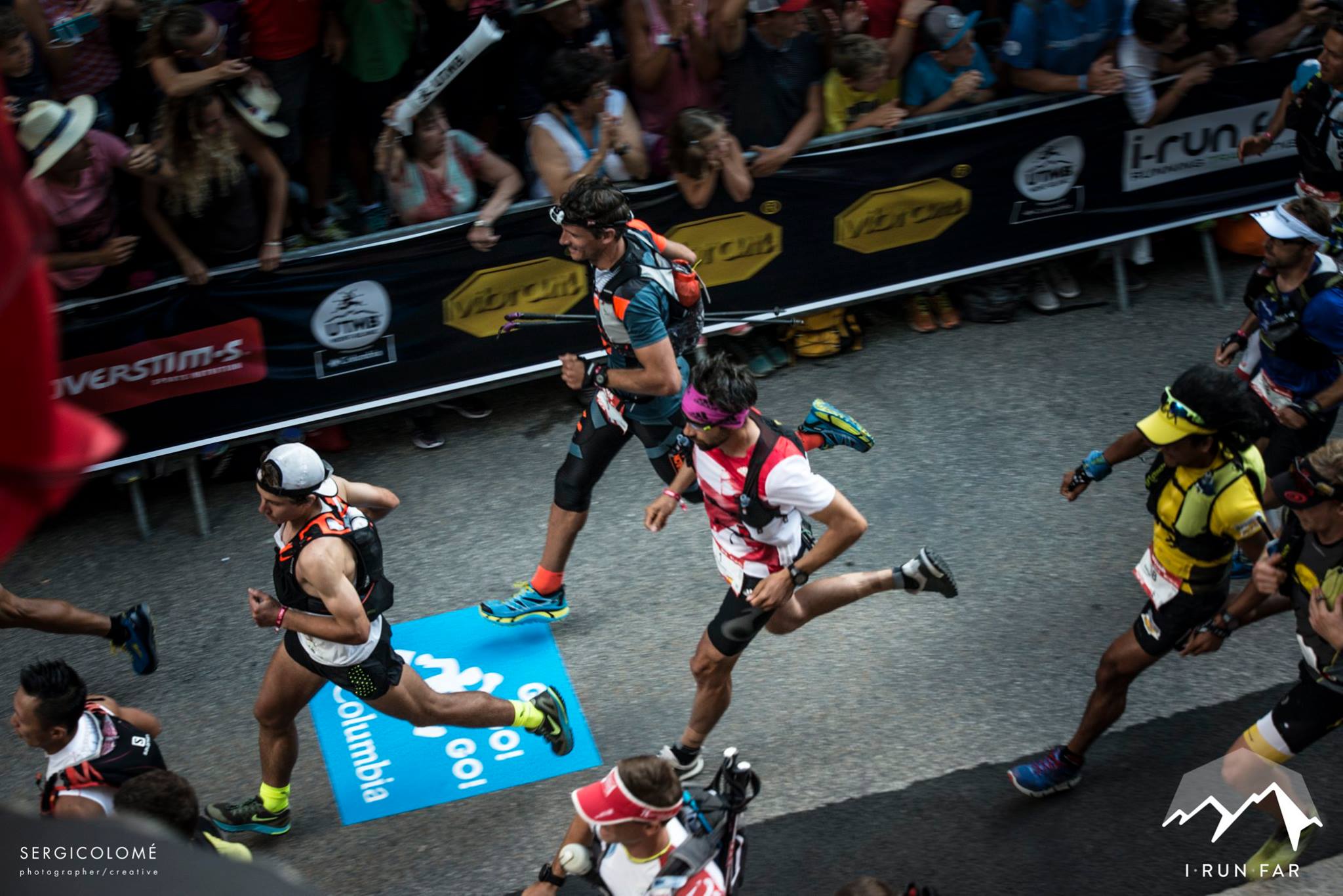
The runners take off down the paved roads of Chamonix, France, at the start of the 2016 UTMB. Photo: Sergi Colome
What trail running shoes should I use to run in mud?
If you’ll hit an occasional short patch of mud on your run, wear whatever trail shoes you want. If mud will be a regular feature on a particular run, try to pick a pair of trail shoes with at least moderate lugs that are 4- to 6-millimeters tall, such as those of the Salomon Speedcross 6 or Hoka Speedgoat 5.
While not covered in this article, there are trail shoes with 7- to 8-millimeter deep lugs, such as the inov-8 Mudclaw 300, that work well in extremely muddy conditions.
For a deep look at the subject, check out our trail running shoes for mud guide.
By the way, keep in mind that good technique can make running in mud more effective.
What’s the most cushioned trail running shoe?
As of 2023, it looks like the Hoka Stinson 6 is the most cushioned trail shoe out there, with the Altra Olympus 5 and Hoka Challenger 7 not far behind.
For more on cushioned trail running shoes, we’ve pulled together a guide to the best cushioned trail running shoes.
Should I wear gaiters with trail running shoes?
Gaiters are fabric collars, often detachable, that cover the top of a shoe and the lower part of the leg to prevent debris from entering a shoe from around its tongue or ankle collar, as well as through more porous areas of the shoe’s upper.
Whether or not you wear gaiters when trail running depends on trail conditions and personal preference. Personally, I never wear gaiters (except when snowshoeing), but many folks like running gaiters, particularly if there’s lots of sand, dust, or other loose debris on the trail.
Many gaiters can be attached to nearly any pair of shoes, while some brands make gaiters that easily integrate with their own trail shoes, such as the Altra Lone Peak 7, Altra Olympus 5, and Topo Ultraventure Pro models noted above.
If you’re looking to buy gaiters, look no further than our best running gaiters guide.
What socks should I wear when trail running?
Good question! For some top picks, check out our article on the best running socks.
Why are trail running shoes so expensive?
All things considered, most trail running shoes aren’t outrageously expensive, and there are plenty of great models at $130 and under. When you factor in inflation, most trail shoes are roughly in line with what they were 20 years ago, although trail running shoe prices have increased.
Interestingly, there did seem to be a pause in the price increases of all running shoes a decade ago when brands hesitated to break the $100 per pair barrier. Once Hokas and the Salomon S-Lab Sense came onto the market, that ceiling was destroyed, and there was a diversification of prices.
So, what about all the trail shoes that cost more than $150? Well, a good portion of them does tend to have a higher fit and finish. Other high-priced trail shoes are pinnacle products with lower anticipated sales of a highly niche shoe and more significant research and development costs.
Is either of these categories worth the premium? Perhaps for a handful of people with significant disposable income, the marginal gains in comfort or prestige are worth the cost of the ultra-premium trail shoes, but they’re certainly not necessary. The same goes for seemingly cutting-edge shoes. Maybe they lead to better performance — or maybe they don’t.
My advice? Wait a season or two before buying truly groundbreaking trail shoes. If they end up as winners, most brands will offer lower-cost, very similar versions within two or three years. If they’re not true winners, you just saved some money.
Can I wear trail running shoes for hiking?
Tons of people use trail running shoes for hiking, whether that’s for an hour around the local park or a three-month thru-hike. Two great options from our list above include the Altra Lone Peak 7 for those who want a wide toebox, perhaps for hours-long or multi-day hikes, or the Brooks Cascadia 16. Both shoes offer moderate cushioning on time-tested platforms.
The Hoka Speedgoat 5 makes a great hiking shoe for those wanting more cushioning.
Can I wear trail running shoes for walking?
Most trail running shoes will be comfortable and effective for walking. Perhaps just avoid trail shoes with overly aggressive lugs. Occasional walks on concrete and asphalt will be fine, but if you’ll mostly be walking hard surfaces, consider buying a pair of road running shoes instead.
Where to Buy Trail Running Shoes?
If you’re in the market for some trail shoes and you have the chance, swing by your local running store to see if they can set you up with a pair. Not only will they have the knowledge to match a pair to your needs and the skill to size the shoes properly, but the store’s selection should also be well-suited for local trails.
Many local outdoor stores also carry a selection of trail running shoes (as they often double as great hiking shoes) that would, once again, be suited for the local environment.
If you know what you’re looking for, online outdoor retailers like REI Co-op and Backcountry carry a huge selection of trail shoes from a multitude of manufacturers. These days, you’re likely to find just as many or more trail shoes on Amazon, with free two-day shipping if you’re a Prime member.
If you’ve still not found a trail shoe that strikes your fancy, you could keep poking around Road Runner Sports, Running Warehouse, and even smaller specialty sites like Skyrun until you find your match.
Back to our top trail running shoes